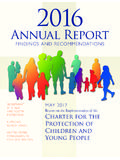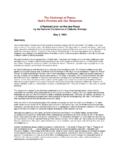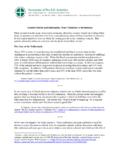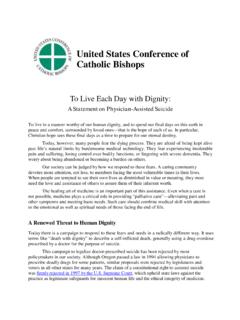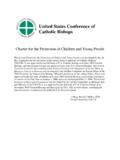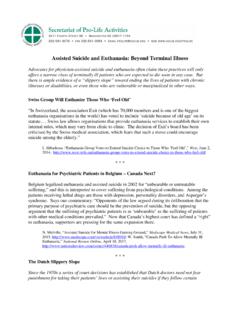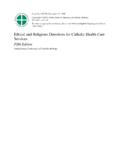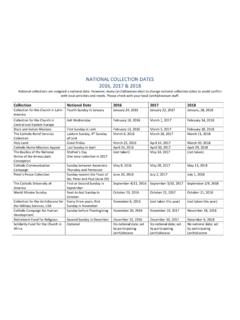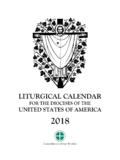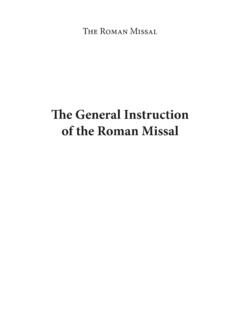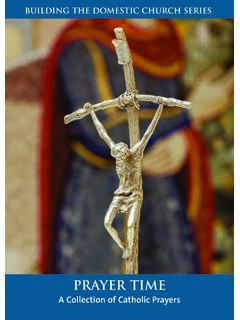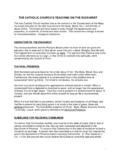Transcription of Catholic Hymnody at the Service of the Church: An ... - USCCB
1 PrefaceThe beauty of Catholic Hymnody is constitutively related to the truth of the mystery of faith it proposes for our wonder and praise. In the living Tradition of Catholicism, beauty and truth are convertible terms, and thus there can be no competition, much less contradic-tion, between the two. The truth of the faith need not be and indeed must not be compromised or subordi-nated to the canons of compositional style or the needs of musical or poetic form. At the same time, the beauty of the faith cannot be neglected indeed it must be rev-erenced and highlighted in the desire to communicate effectively the truth of what has been revealed.
2 Catholic hymn-writers and composers necessarily inhabit a realm of creative interplay: they have the privilege and voca-tion of honoring and communicating the mystery of faith in word and music, and this requires genuine art-istry, industry, and fidelity. While there are a number of factors that affect the suitability of hymns for use in Catholic liturgy, such as singability, beauty of language, poetry, etc., in this resource we are concerned with their doctrinal content. The Church s Liturgy is the milieu in which the Word of God lives. The Sacred Scriptures, in particu-lar, provide the normative idiom for the expression of the mystery .
3 The Scriptures themselves, inspired and authoritative, are the fruit of the Church at prayer ; the 1 The guidelines offered in this document apply to lyrics composed for any music intended for use in the Sacred Liturgy or in public devo-tions, such as the Stations of the or doxological matrix intrinsic to the Church s life is the locus in which and from which the texts privileged as canonical arose. There is a necessary and direct relationship between the living Word of God and the Church s worship. Thus, the sacred texts, and the liturgical sources which draw on the living Word, provide something of a norm for expression when communicating the mystery of faith in liturgical poetics, or Hymnody .
4 The Catechism of the Catholic Church puts it this way, following the texts of Sacrosanctum Concilium: The harmony of signs (song, music, words, and actions) is all the more expressive and fruitful when expressed in the cultural richness of the People of God who celebrate. Hence religious singing by the faithful is to be intelligently fos-tered so that in devotions and sacred exercises as well as in liturgical services, in conformity with the Church s norms, the voices of the faith-ful may be heard. But the texts intended to be sung must always be in conformity with Catholic doctrine.
5 Indeed they should be drawn chiefly from the Sacred Scripture and from liturgical sources. (no. 1158) Christian tradition, both Eastern and Western, has from antiquity been acutely aware that hymns and other songs1 are among the most significant forces in shaping or misshaping the religious and theological Catholic Hymnody at the Service of the Church: An Aid for Evaluating Hymn LyricsCOMMITTEE ON DOCTRINEUNITED STATES CONFERENCE OF Catholic BISHOPSSEPTEMBER 20202 Catholic Hymnody at the Service of the Church: An Aid for Evaluating Hymn Lyrics is a statement of the Committee on Doctrine. It was authorized by the USCCB Administrative Committee at its September 2020 meeting.
6 It has been directed for publication by the undersigned. Msgr. J. Brian Bransfield, STDG eneral Secretary, USCCB sensibility of the It is all the more important, then, that Hymnody selected for the liturgical life of the Church successfully draw out the beauty of the Christian mysteries This cannot be done if language is used that is out of keeping with the sensibility created by scriptural texts and universal liturgical usage. Two General GuidelinesBased on the text quoted above, we can derive two general guidelines for determining whether a hymn is doctrinally suitable for liturgical use:1. Is the hymn in conformity with Catholic doctrine?
7 2. Is the hymn expressed in image and vocabulary appropriately reflective of the usage of Scripture and the public liturgical prayer of the Church? With regard to Guideline 1: An accurate assessment of conformity with Catholic doctrine requires a familiar-ity with Catholic doctrine itself, and the Catechism of the Catholic Church is the best resource available. Hymns do not have to be composed of doctrinal formulae (though hymns have used doctrinal formulas to good poetic effect, for example, the last verse of Pange lingua). It is important to avoid language that could be easily miscon-strued in a way that is contrary to Catholic doctrine.
8 The poet always has a certain license for language chosen to serve an aesthetic purpose. But in assessing whether a paraphrase or restatement is an appropriate use of poetic license or an inappropriate distortion, Guideline 2 can provide assistance. These Guidelines can also be helpful in assessing a grouping of hymns and other songs, such as those com-2 The Catechism of the Catholic Church describes the liturgy as the privileged place for catechizing the People of God (no. 1074).3 The 23 July 2019 report by the Pew Research Center, What Americans Know about Religion, presents a sobering account the extent of the lack of understanding of basic points of Catholic faith on the part of many American Catholics ( ).
9 For example, the researchers found that only half of Catholics were able to answer correctly a question about official church teachings on transubstantiation that during Communion, the bread and wine actually become the body and blood of Christ. The other half of Catholics incorrectly say the church teaches that the bread and wine used in Communion are just symbols of the body and blood of Christ (45%) or say they are not sure (4%) (p. 22).monly used in a given parish for the Communion Hymn (for example). Different hymns may legitimately express or reflect different aspects of one doctrine, but if all of the hymns relevant to a particular doctrine express only one dimension of the doctrine to the exclusion of others, then the catechesis offered by the Hymnody would, as a whole, not be in conformity with Catholic doctrine.
10 For example, a collection of hymns that emphasized the Eucharist as table fellowship to the exclusion of the vocabulary of sacrifice, altar, and priesthood, would not represent the fullness of Catholic teaching and therefore would catechize those singing such hymns every Sunday with a deficient sacramental theology. Examples of Application of the GuidelinesIn 1997, Archbishop Daniel Buechlein, speaking for the newly-formed Ad Hoc Committee to Oversee the Use of the Catechism, identified a consistent trend of incom-pleteness and imprecision in catechetical texts being pub-lished at that time in the United States. He summarized this trend in a list of ten categories (see Appendix One below).
